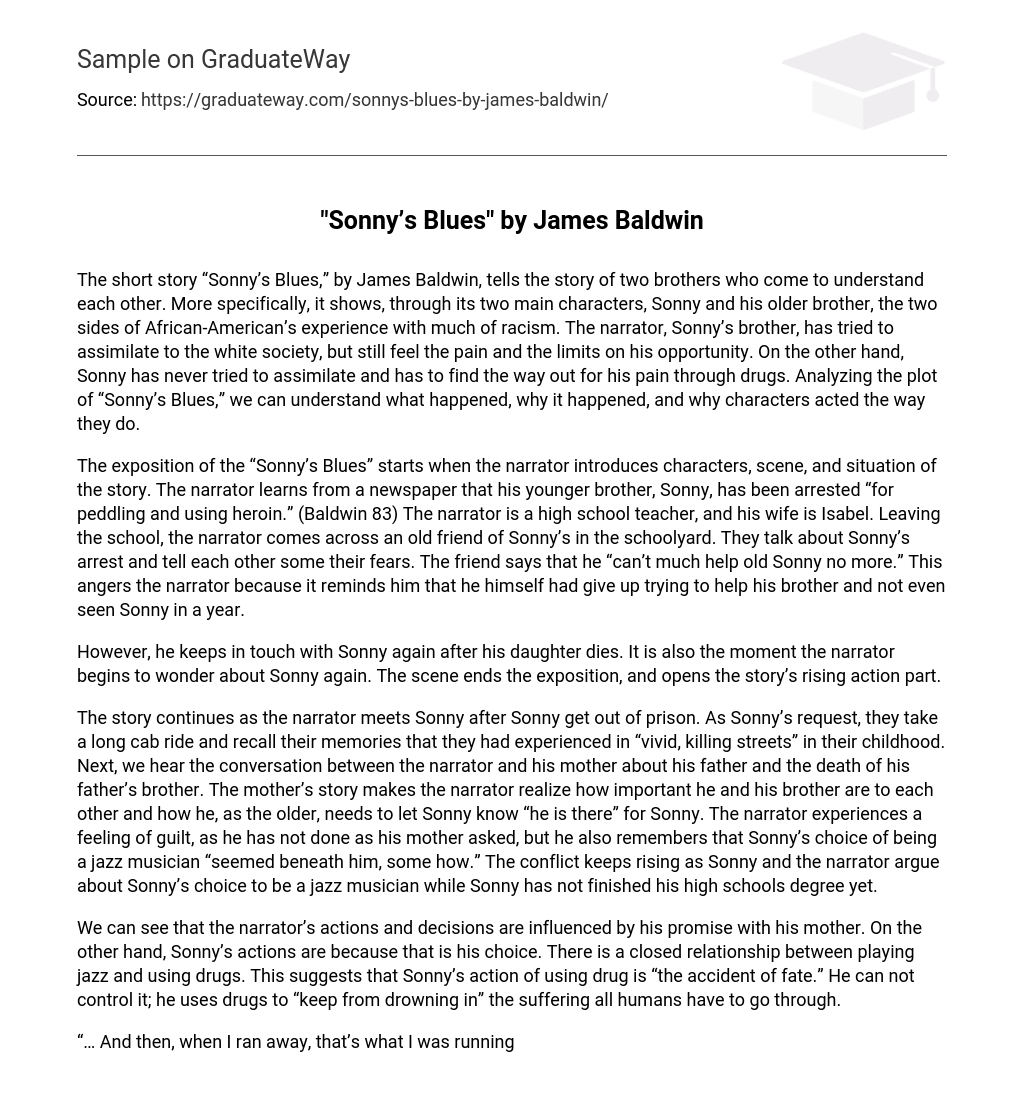The text “Sonny’s Blues,” written by James Baldwin, delves into the connection between two siblings and their encounters with racism. The primary characters, Sonny and his elder brother, embody distinct facets of the African-American ordeal. Sonny’s sibling has strived to integrate into white society while still enduring the anguish and constraints imposed by racism. In contrast, Sonny has opted against assimilation and resorts to drugs as a means of dealing with his suffering. Through examining the storyline of “Sonny’s Blues,” we can obtain comprehension regarding the occurrences, motivations, and conduct of the characters.
The opening of “Sonny’s Blues” introduces the characters, setting, and situation. The narrator learns from a newspaper article that his younger brother, Sonny, has been arrested for heroin-related activities. As a high school teacher married to Isabel, the narrator leaves work and meets an old friend of Sonny in the schoolyard. They discuss Sonny’s arrest and share their fears. The friend admits his inability to continue helping Sonny, which frustrates the narrator as it reminds him of his own abandonment of his brother for a whole year.
However, after the death of his daughter, the narrator reconnects with Sonny, leading him to ponder about him once more. This pivotal moment marks the conclusion of the exposition and sets the stage for the story’s rising action.
The narrator meets Sonny after his release from prison and they take a long cab ride, reminiscing about their childhood memories in the “vivid, killing streets.” Later, the narrator discusses his father and his father’s brother’s death with his mother, leading him to realize the importance of their bond as brothers and his responsibility as the older one to support Sonny. However, the narrator feels guilty for not fulfilling his mother’s request. Additionally, he also has reservations about Sonny’s decision to become a jazz musician, thinking it is beneath him. This conflict intensifies as they argue about Sonny pursuing jazz without completing high school.
The narrator’s actions and decisions are directly impacted by his commitment to his mother, whereas Sonny’s actions are solely driven by his own choices. The association between playing jazz and drug use suggests a significant link, indicating that Sonny’s drug use is not entirely under his control, but rather a consequence of fate. He turns to drugs as a way to cope with the shared anguish experienced by all individuals.
“…And then, when I escaped, that is what I was fleeing from…nothing was different, I had not transformed, I was simply more mature.” (Baldwin 102)
Sonny attempts to break free from the grip of drugs, but his efforts are in vain. During a discussion with the narrator following their attendance at a traditional revival meeting, Sonny opens up about relapsing back into drug use.
“Here it comes again. Okay,” said Sonny’s brother.
Sonny responded, stating his need to inform the listener.
Sonny’s brother repeated multiple times, saying “Yes, I understand that … I understand that …”
The climax of the story occurs when Sonny and his brother gain a mutual understanding.
In the falling action of the story, the narrator accompanies Sonny to a jazz club where he faces challenges reuniting with his music band due to a lack of practice. Despite this, Sonny takes charge of the situation and starts playing “Am I blue,” ultimately feeling a sense of belonging and becoming reconnected with his musical family.
The tale reaches its resolution as the narrator acknowledges that music has aided Sonny in maintaining his freedom. Additionally, the narrator realizes that the power of the blues can enable individuals to stay authentic to themselves and their identity.
“Sonny’s Blues” emphasizes the importance of following one’s own decisions and judgments for their future. It also highlights the incorrectness of prejudice. However, it distinguishes between prejudice and the advice given by elders. These pieces of wisdom are valuable experiences acquired by elders through their lives, and can provide individuals with guidance in choosing their career or way of life.
Baldwin, James. “Sonny’s Blues.” The Story and Its Writers. Boston: Harold Ober Association, Inc., 1999. Pages 82-106.





